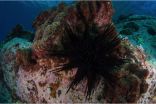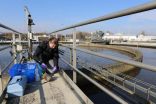(Press-News.org) Oceans have absorbed up to 30 percent of human-made carbon dioxide around the world, storing dissolved carbon for hundreds of years. As the uptake of carbon dioxide has increased in the last century, so has the acidity of oceans worldwide. Since pre-industrial times, the pH of the oceans has dropped from an average of 8.2 to 8.1 today. Projections of climate change estimate that by the year 2100, this number will drop further, to around 7.8 -- significantly lower than any levels seen in open ocean marine communities today.
Now a team of researchers from MIT, the University of Alabama, and elsewhere has found that such increased ocean acidification will dramatically affect global populations of phytoplankton -- microorganisms on the ocean surface that make up the base of the marine food chain.
In a study published today in the journal Nature Climate Change, the researchers report that increased ocean acidification by 2100 will spur a range of responses in phytoplankton: Some species will die out, while others will flourish, changing the balance of plankton species around the world.
The researchers also compared phytoplankton's response not only to ocean acidification, but also to other projected drivers of climate change, such as warming temperatures and lower nutrient supplies. For instance, the team used a numerical model to see how phytoplankton as a whole will migrate significantly, with most populations shifting toward the poles as the planet warms. Based on global simulations, however, they found the most dramatic effects stemmed from ocean acidification.
Stephanie Dutkiewicz, a principal research scientist in MIT's Center for Global Change Science, says that while scientists have suspected ocean acidification might affect marine populations, the group's results suggest a much larger upheaval of phytoplankton -- and therefore probably the species that feed on them -- than previously estimated.
"I've always been a total believer in climate change, and I try not to be an alarmist, because it's not good for anyone," says Dutkiewicz, who is the paper's lead author. "But I was actually quite shocked by the results. The fact that there are so many different possible changes, that different phytoplankton respond differently, means there might be some quite traumatic changes in the communities over the course of the 21st century. A whole rearrangement of the communities means something to both the food web further up, but also for things like cycling of carbon."
The paper's co-authors include Mick Follows, an associate professor in MIT's Department of Earth, Atmospheric and Planetary Sciences.
Winners and losers
To get a sense for how individual species of phytoplankton react to a more acidic environment, the team performed a meta-analysis, compiling data from 49 papers in which others have studied how single species grow at lower pH levels. Such experiments typically involve placing organisms in a flask and recording their biomass in solutions of varying acidity.
In all, the papers examined 154 experiments of phytoplankton. The researchers divided the species into six general, functional groups, including diatoms, Prochlorococcus, and coccolithophores, then charted the growth rates under more acidic conditions. They found a whole range of responses to increasing acidity, even within functional groups, with some "winners" that grew faster than normal, while other "losers" died out.
The experimental data largely reflected individual species' response in a controlled laboratory environment. The researchers then worked the experimental data into a global ocean circulation model to see how multiple species, competing with each other, responded to rising acidity levels.
The researchers paired MIT's global circulation model -- which simulates physical phenomena such as ocean currents, temperatures, and salinity -- with an ecosystem model that simulates the behavior of 96 species of phytoplankton. As with the experimental data, the researchers grouped the 96 species into six functional groups, then assigned each group a range of responses to ocean acidification, based on the ranges observed in the experiments.
Natural competition off balance
After running the global simulation several times with different combinations of responses for the 96 species, the researchers observed that as ocean acidification prompted some species to grow faster, and others slower, it also changed the natural competition between species.
"Normally, over evolutionary time, things come to a stable point where multiple species can live together," Dutkiewicz says. "But if one of them gets a boost, even though the other might get a boost, but not as big, it might get outcompeted. So you might get whole species just disappearing because responses are slightly different."
Dutkiewicz says shifting competition at the plankton level may have big ramifications further up in the food chain.
"Generally, a polar bear eats things that start feeding on a diatom, and is probably not fed by something that feeds on Prochlorococcus, for example," Dutkiewicz says. "The whole food chain is going to be different."
By 2100, the local composition of the oceans may also look very different due to warming water: The model predicts that many phytoplankton species will move toward the poles. That means that in New England, for instance, marine communities may look very different in the next century.
"If you went to Boston Harbor and pulled up a cup of water and looked under a microscope, you'd see very different species later on," Dutkiewicz says. "By 2100, you'd see ones that were living maybe closer to North Carolina now, up near Boston."
Dutkiewicz says the model gives a broad-brush picture of how ocean acidification may change the marine world. To get a more accurate picture, she says, more experiments are needed, involving multiple species to encourage competition in a natural environment.
"Bottom line is, we need to know how competition is important as oceans become more acidic," she says.
INFORMATION:
This research was funded in part by the National Science Foundation, and the Gordon and Betty Moore Foundation.
Additional background
ARCHIVE: Storing carbon in the Arctic
ARCHIVE: Winners and losers in a warming ocean
ARCHIVE: Ocean source of a greenhouse gas has been underestimated END
Marine species that already roam far and wide throughout our oceans are extending their territories further and faster in response to climate change, according to new research involving the University of Southampton and an international team of biodiversity experts.
The study found that while species that have large ranges are able to make their way to cooler waters, small-ranging species are in increased jeopardy as our planet's oceans continue to warm.
"Our findings indicate that animals which already have wide-latitudinal ranges, habitat generalists, and species with ...
New Haven, Conn. -- Researchers at Yale School of Medicine have successfully treated patients with moderate to severe eczema using a rheumatoid arthritis drug recently shown to reverse two other disfiguring skin conditions, vitiligo and alopecia areata. The study is evidence of a potential new era in eczema treatment, they report.
The research findings are published early online in the Journal of the American Academy of Dermatology.
Eczema (atopic dermatitis) is a chronic condition that causes severe itching and leaves the skin red and thickened. It can adversely affect ...
A slow-down in global warming is not a sign that climate change is ending, but a natural blip in an otherwise long-term upwards trend, research shows.
In a detailed study of more than 200 years' worth of temperature data, results backed previous findings that short-term pauses in climate change are simply the result of natural variation.
The findings support the likelihood that a current hiatus in the world's year-on-year temperature increases - which have stalled since 1998 - is temporary.
Scientists from the University of Edinburgh analysed real-world historic ...
Research findings obtained over the past decades increasingly indicate that stored memories are coded as permanent changes of neuronal communciation and the strength of neuronalinterconnections. The learning process evokes a specific pattern of electrical activity in these cells, which influences the response behavior to incoming signals, the expression of genes and the cellular morphology beyond the learning process itself.
"You might say that these changes define the cellular correlate of the memory engram" says Friedrich Johenning, researcher at the Neuroscience Research ...
Researchers from the Institute and Department of Psychiatry, Faculty of Medicine, University of São Paulo, (Brazil); the Imperial College of London, (UK); the University of Western Australia (Australia) and the University of Toronto (Canada) have just published a study in the Journal of Psychopharmacology suggesting that what had been clustered as anxiety disorders is not homogenous in terms of functioning of the serotonergic system.
The researchers reanalyzed the results of six other studies that had evaluated the effects of the acute reduction of tryptophan, the ...
Microbial ecosystems such as biological wastewater treatment plants and the human gastrointestinal tract are home to a vast diversity of bacterial species. Scientists of the Luxembourg Centre for Systems Biomedicine (LCSB) and the Life Science Research Unit (LSRU) of the University of Luxembourg, in collaboration with US researchers, have now succeeded for the first time in determining key functional genes and the organisms encoding these in such ecological systems, working from extensive data of bacterial genetics and bacterial metabolism.
Keystone species are species ...
The term intellectual disability covers a large number of clinical entities, some with known cause and others of uncertain origin. For example Down syndrome is due to an extra copy of chromosome 21 and Rett syndrome is in part caused by a mutation in the control switch gene called MeCP2.
In other cases the mechanisms by which they are produced are not clearly identified. It is the case of most of those disorders classified under the large umbrella of autism. An study published in the journal Genetics in Medicine, by Manel Esteller, director of the Program Epigenetics ...
Barbara Hinney and her colleagues from the Institute for Parasitology at the University of Veterinary Medicine, Vienna, screened 298 faecal samples taken from cats across Austria for single-cell intestinal parasites, so called enteric protozoa. The samples came from private households, catteries and animal shelters. Of the 298 cats sampled, 56 tested positive with at least one intestinal parasite.
Multi-cat households often affected
A significantly higher rate of positive samples was registered in households with more than one cat. Households with kittens are also ...
This study has developed a unique bioinformatics approach for identifying associations between molecules from a range of vast data sources. Applied to studies with the aim to measure metabolism in tissues under variating conditions e.g. genetics, diets and environment.
Opposed to current methods that apply statistical analysis to data sets as a whole, the proposed workflow breaks the initial data into smaller groups determined by known molecular interactions. Statistical methods can then be applied to these groups resulting in more accurate results than if the analysis ...
Galaxies in a cluster roughly 300 million light years from Earth could contain as much as 100 times more dark matter than visible matter, according to an Australian study.
The research, published today, used powerful computer simulations to study galaxies that have fallen into the Coma Cluster, one of the largest structures in the Universe in which thousands of galaxies are bound together by gravity.
"It found the galaxies could have fallen into the cluster as early as seven billion years ago, which, if our current theories of galaxies evolution are correct, suggests ...




